The Common Cuckoo (Cuculus canorus) is a charismatic bird species known for its unique reproductive strategy and distinctive vocalizations.
Found across Europe and Asia, these medium-sized, long-winged birds are renowned for their remarkable migratory journeys, covering thousands of kilometers during their annual travels.
One of the most fascinating aspects of the Common Cuckoo’s behavior is its brood parasitism, wherein females lay their eggs in the nests of other bird species, leaving the unwitting hosts to raise the cuckoo chicks.
This behavior has intrigued scientists for centuries and remains a subject of intensive study in ornithology.
The male Common Cuckoo is recognized for its musical and easily identifiable “cu-coo” call, often associated with the arrival of spring in many regions.
Physical Characteristics of Common Cuckoo
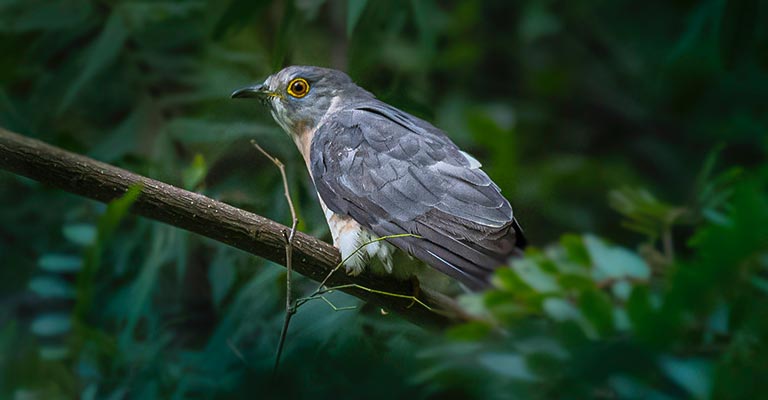
The Common Cuckoo (Cuculus canorus) boasts distinctive physical characteristics that set it apart in the avian world, making it relatively easy to identify.
These features, ranging from plumage to size and shape, contribute to the bird’s unique charm and play a crucial role in its survival strategies.
Sleek and Slender Build
The Common Cuckoo exhibits a streamlined and slender physique, with a body length of approximately 32-34 centimeters. Its long wings and relatively short tail give it a distinctive and elegant silhouette in flight.
Cryptic Plumage
The plumage of the Common Cuckoo is characterized by a subtle blend of gray and brown tones, providing effective camouflage in various environments.
This cryptic coloration aids the bird’s nesting behavior, allowing it to approach host nests inconspicuously.
Notable Markings
A key identifying feature is the bird’s bold barring on the underparts, particularly the belly and breast. The barred pattern consists of dark lines and lighter spaces, contributing to the Common Cuckoo’s visual appeal.
Distinctive White Eyebrow
One of the most striking features is the white, crescent-shaped eyebrow that extends above the eye. This distinctive marking adds a touch of elegance to the bird’s appearance and aids observers in differentiating it from other species.
Hawk-Like Flight
In flight, the Common Cuckoo exhibits a distinctive, falcon-like flight pattern. Its long wings and agile maneuvers contribute to its ability to cover considerable distances during migration.
This hawk-like flight style is a characteristic feature when observing the bird in the sky.
Long Tail with White Edges
The Common Cuckoo’s tail is relatively long, with distinctive white edges on the outer feathers. This feature becomes particularly noticeable when the bird is in flight or perched, providing additional visual cues for identification.
Inconspicuous Sex Differences
Unlike many bird species, male and female Common Cuckoos do not display significant differences in plumage, making it challenging to distinguish between the sexes based on external features alone.
Both genders share the same cryptic coloration and distinctive markings.
Vocal Signature
Beyond physical characteristics, the Common Cuckoo is renowned for its unmistakable call, a two-note “cu-coo” that echoes through its habitats.
This vocal signature, often associated with the arrival of spring, serves as an auditory clue for birdwatchers identifying this enigmatic species.
The Common Cuckoo’s physical characteristics collectively contribute to its unique identity, from its sleek build to its distinctive plumage and vocalizations.
These features make it a fascinating subject for bird enthusiasts and play essential roles in its ecological interactions and reproductive strategies.
Taxonomy of Common Cuckoo
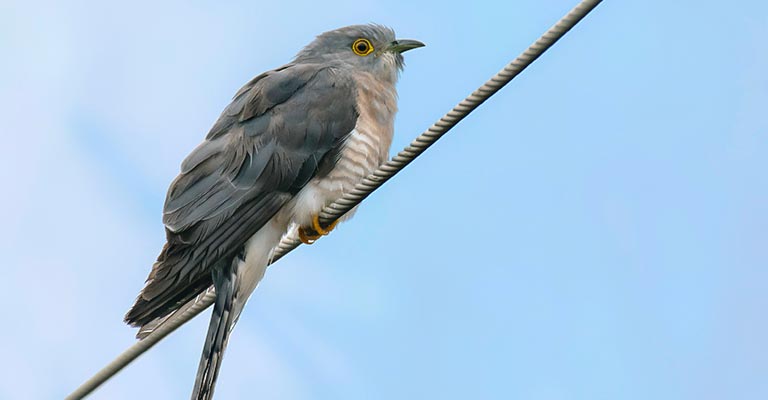
This table will showcase all the taxonomy details of the Common Cuckoo:
| Taxonomic Level | Classification |
| Domain | Eukaryota |
| Kingdom | Animalia |
| Phylum | Chordata |
| Class | Aves |
| Order | Cuculiformes |
| Family | Cuculidae |
| Genus | Cuculus |
| Species | C. canorus |
The Common Cuckoo (Cuculus canorus) is a widespread bird species with several distinct subspecies, each adapted to specific regions and exhibiting unique migratory patterns.
Here are detailed descriptions of some of the subspecies:
C. c. canorus (Nominate Subspecies)
The nominate subspecies, described by Carl Linnaeus in 1758, is found from Ireland through Scandinavia, northern Russia, and Siberia to Japan in the east. It extends from the Pyrenees through Turkey, Kazakhstan, Mongolia, north of China, and Korea.
During winter, it migrates to Africa and South Asia. This subspecies represents the typical Common Cuckoo with its well-known features, including the sleek build, cryptic plumage, and distinctive vocalizations.
C. c. bakeri
First described by Hartert in 1912, C. c. bakeri breeds in western China to the Himalayan foothills in northern India, Nepal, Myanmar, northwestern Thailand, and southern China.
Its winter range includes Assam, East Bengal, and southeastern Asia. This subspecies demonstrates the adaptability of the Common Cuckoo to diverse habitats, with specific characteristics tailored to its breeding and wintering grounds.
C. c. bangsi
Described by Oberholser in 1919, C. c. bangsi breeds in Iberia, the Balearic Islands, and North Africa. It migrates to Africa during the winter months.
This subspecies showcases the geographical variation in plumage and behavior that can arise within the broader Common Cuckoo population, highlighting the species’ ability to thrive in distinct ecosystems.
C. c. subtelephonus
First described by Zarudny in 1914, C. c. subtelephonus breeds in Central Asia, spanning from Turkestan to southern Mongolia. During the winter, it migrates to southern Asia and Africa.
This subspecies represents the adaptability of the Common Cuckoo across different climates and landscapes, emphasizing its role as a migratory species with a wide-ranging distribution.
These subspecies underscore the Common Cuckoo’s ability to inhabit diverse environments, from the Arctic regions of Scandinavia to the Himalayan foothills and the Mediterranean.
The variations in plumage, breeding locations, and migration routes contribute to the species’ overall ecological success and resilience across its vast range.
Studying these subspecies enhances our understanding of the intricate relationships between migratory birds and their habitats, emphasizing the importance of conservation efforts to safeguard their diverse populations.
Common Food of Common Cuckoo
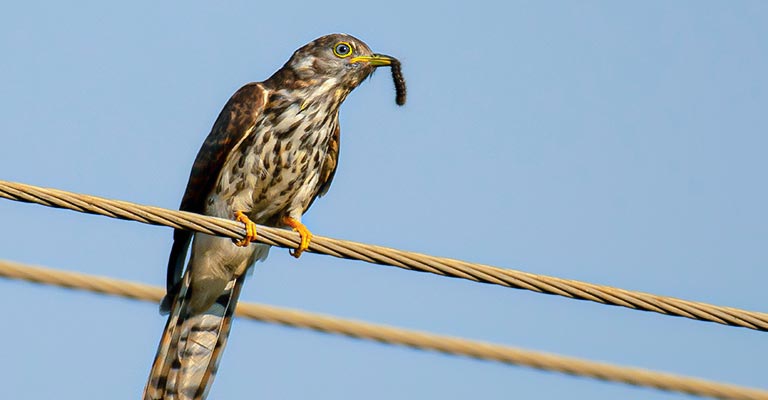
The Common Cuckoo (Cuculus canorus) exhibits a varied diet comprising insects and caterpillars.
These birds are known for their unique reproductive strategy of laying eggs in the nests of other bird species, leaving them responsible for raising their chicks.
The Common Cuckoo’s food habits align with its migratory lifestyle, requiring substantial energy for long-distance flights.
- Insects and Caterpillars: Common Cuckoos primarily feed on many insects and caterpillars, including beetles, moths, and butterflies. Their agile flight and slender build make them adept at catching insects mid-air.
- Dietary Adaptations: During the breeding season, the Common Cuckoo’s diet may shift to more giant insects, such as hairy caterpillars, providing essential nutrients for adult birds and their developing chicks.
- Nocturnal Foraging: Common Cuckoos are known to forage day and night, expanding their opportunities to locate and consume diverse insects and invertebrates.
These dietary habits underline the bird’s adaptability and reliance on a protein-rich diet to support its demanding lifestyle, including migration, reproduction, and overall energy levels.
Common Cuckoo Life History
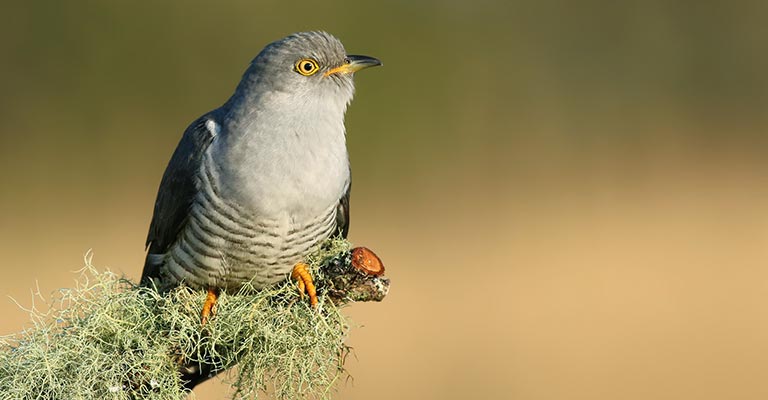
The life history of the Common Cuckoo (Cuculus canorus) is a fascinating narrative that unfolds across varied habitats, encompassing intricate nesting strategies, migratory journeys, and interactions with other avian species.
This enigmatic bird’s survival is intricately linked with its ability to adapt to diverse environments. From its habitat selection to the challenges of diseases, the Common Cuckoo’s life history weaves a tale of resilience and ecological significance.
Habitat
The Common Cuckoo occupies many habitats, including woodlands, heathlands, and meadows. Its adaptability allows it to thrive in environments ranging from Arctic tundra to temperate and subtropical regions.
Range Map
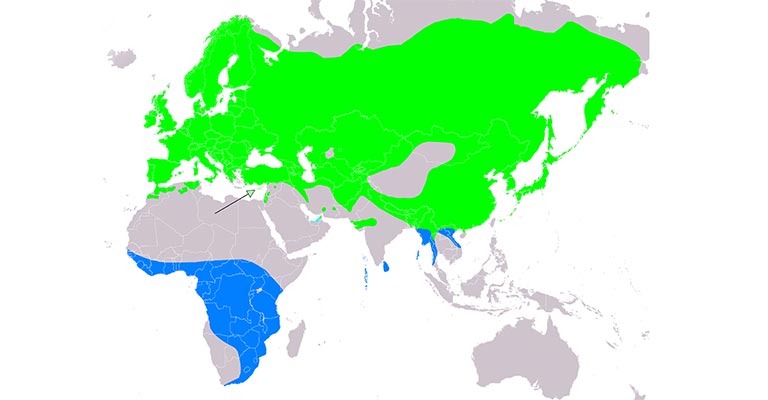
The species exhibits an expansive range from Ireland through Scandinavia to northern Russia and Siberia, extending to Japan in the east.
Its migration routes cover vast distances, with wintering grounds in Africa and South Asia, showcasing remarkable ecosystem connectivity.
Nesting
Known for its brood parasitism, female Common Cuckoos lay their eggs in the nests of other bird species, tricking them into raising their chicks. This strategy often involves selecting hosts with similar eggs and nestlings to minimize detection.
| Nesting Details of Common Cuckoo | Facts |
| Clutch Size | Typically 1 egg |
| Number of Broods | Usually 1 per season |
| Egg Length | Approximately 2.2 to 2.6 centimeters |
| Egg Width | Around 1.4 to 1.6 centimeters |
| Incubation Period | 12-14 days, handled by host species |
| Nestling Period | 17-21 days, cared for by host species |
| Egg Description | Variable, mimicking host species’ eggs; coloration and patterns may differ |
Breeding
The breeding season sees the males actively participating in courtship displays, showcasing their distinctive calls and aerial acrobatics.
Once the female has laid her eggs in a host nest, the Common Cuckoo leaves the responsibility of incubation and chick-rearing to the unwitting host species.
Diseases
Like many avian species, Common Cuckoos are susceptible to diseases that can impact their health and reproductive success. Avian diseases such as avian influenza or parasites can threaten individual birds and populations.
Treatment
Mitigating disease risks involves monitoring population health, understanding the transmission pathways, and implementing conservation measures.
Research into disease-resistant behaviors and genetic factors may contribute to the development of effective treatments.
Conservation
Conservation efforts for the Common Cuckoo must address habitat loss, climate change, and the potential impact of diseases. Preserving diverse habitats, particularly in breeding and wintering areas, is essential.
Raising awareness about the species’ ecological importance and advocating for sustainable practices can also contribute to its long-term conservation.
In essence, the life history of the Common Cuckoo is a tale of adaptation and survival, where ecological interdependence and the challenges posed by changing environments underscore the need for proactive conservation measures.
Behavioral Habits of Common Cuckoo
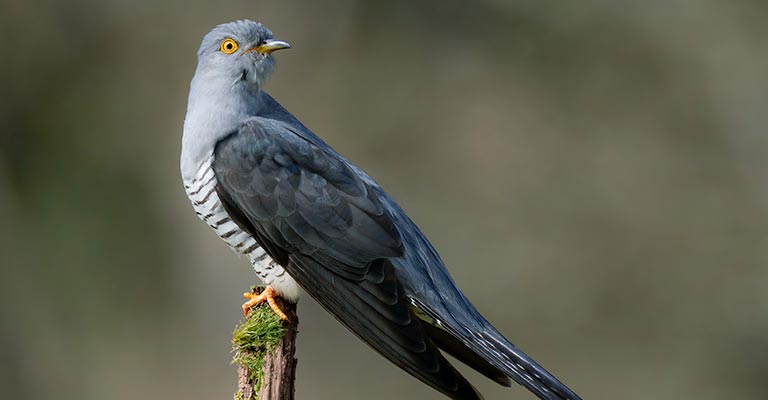
The behavioral habits of the Common Cuckoo (Cuculus canorus) are as intriguing as they are unique, showcasing a repertoire of adaptations and strategies that contribute to its survival in diverse environments.
From its distinctive vocalizations to its notorious brood parasitism, the Common Cuckoo’s behaviors are a testament to its evolutionary success and complex ecological interactions.
Vocalizations and Communication
One of the most distinctive features of the Common Cuckoo is its vocalizations. The male’s two-note “cu-coo” call resonates through its habitat, serving as a territorial declaration and a means of attracting mates.
This iconic sound is often associated with the arrival of spring in many regions, symbolizing the changing seasons.
Brood Parasitism
The Common Cuckoo’s reproductive strategy is a marvel of behavioral adaptation. Females lay their eggs in the nests of other bird species, exploiting the parental care of unwitting hosts.
The eggs often mimic the appearance of the host species’ eggs, reducing the likelihood of detection. Once hatched, the cuckoo chick instinctively evicts host eggs and nestlings, monopolizing the parental care provided by the foster parents.
Foraging Behavior
Common Cuckoos are agile in flight and exhibit diurnal and nocturnal foraging behaviors. Their slender build and long wings contribute to their ability to catch insects, their primary food source, in mid-air.
The adaptability of their foraging patterns ensures a steady intake of protein-rich insects crucial for their energy-intensive activities, including migration.
Migratory Instinct
The Common Cuckoo is renowned for its impressive migratory journeys. Covering thousands of kilometers, these birds navigate between European and Asian breeding grounds to wintering areas in Africa and South Asia.
Their migratory instinct is critical for accessing abundant food resources and suitable nesting sites.
Interaction with Host Species
The relationship between the Common Cuckoo and its host species is complex. While the cuckoo exploits the parental care hosts provide through brood parasitism, it may also exhibit certain adaptations to avoid host retaliation.
Studies suggest that cuckoo eggs may evolve to closely resemble those of the host species, reducing the chances of hosts recognizing and rejecting foreign eggs.
The behavioral habits of the Common Cuckoo unveil a captivating tapestry of adaptations shaped by evolution. From its vocal acumen to the intricacies of brood parasitism, these behaviors underscore the species’ resilience and success in diverse ecosystems.
Wrapping Up
The Common Cuckoo’s life history, characterized by brood parasitism and extensive migratory journeys, unravels a story of survival intricately intertwined with ecological dynamics.
Its behavioral habits, from vocalizations to foraging techniques, underscore the evolutionary strategies that have allowed this species to thrive across continents.
As conservation concerns loom, understanding and appreciating the Common Cuckoo’s role in ecosystems becomes paramount.
Conservation efforts must address the challenges posed by habitat loss, climate change, and potential disease threats to ensure the perpetuation of this enigmatic bird.
The Common Cuckoo beckons us to delve deeper into the complexities of avian life, urging us to cherish and safeguard the intricate balance of nature it embodies.